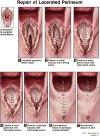Techniques for Repair of Obstetric Anal Sphincter Injuries
- PMID: 29368789
- PMCID: PMC5788295
- DOI: 10.1097/OGX.0000000000000521
Techniques for Repair of Obstetric Anal Sphincter Injuries
Abstract
Importance: Obstetric anal sphincter injuries (OASISs) complicate up to 11% of vaginal deliveries; obstetricians must be able to recognize and manage these technically challenging injuries.
Objective: The aim of this study was to share our approach for management of these challenging complications of childbirth based on a multidisciplinary collaboration between general obstetrician-gynecologists, maternal fetal medicine specialists, and female pelvic medicine and reconstructive surgeons established at our institution.
Evidence acquisition: A systematic literature search was performed in 3 search engines: PubMed 1946-, EMBASE 1947-, and the Cochrane Database of Systematic Reviews using keywords obstetric anal sphincter injuries and episiotomy repair.
Results: Identification should begin with an assessment of risk factors, notably nulliparity and operative vaginal delivery, consistently associated with the highest risk of OASISs, and proceed with a thorough examination to grade the degree of laceration. Repair should be performed or supervised by an experienced clinician in an operating room with either regional or general anesthesia. The external anal sphincter may be repaired using either an overlapping or end-to-end anastomosis. Providers should be comfortable with both approaches as the degree of laceration may necessitate one approach over the other. We advocate for use of monofilament suture on all layers to decrease risk of bacterial seeding, as well as preoperative antibiotics and postoperative bowel regimen, which are associated with improved outcomes.
Conclusions and relevance: Long-term sequelae, including pain, dyspareunia, and fecal incontinence, significantly impact quality of life for many patients who suffer OASISs and may be avoided if evidence-based guidelines for recognition and repair are utilized.
Conflict of interest statement
The authors report no conflict of interest
Figures

References
-
- Dudding TC, Vaizey CJ, Kamm MA. Obstetric anal sphincter injury: incidence, risk factors, and management. Annals of surgery. 2008;247(2):224–237. - PubMed
-
- Uppal S, Harmanli O, Rowland J, et al. Resident competency in obstetric anal sphincter laceration repair. Obstet Gynecol. 2010;115(2 Pt 1):305–309. - PubMed
-
- Siddighi S, Kleeman SD, Baggish MS, et al. Effects of an educational workshop on performance of fourth-degree perineal laceration repair. Obstet Gynecol. 2007;109(2 Pt 1):289–294. - PubMed
-
- Practice Bulletin No. 165: Prevention and Management of Obstetric Lacerations at Vaginal Delivery. Obstetrics & Gynecology. 2016;128(1):e1–e15. - PubMed
-
- Friedman AM, Ananth CV, Prendergast E, et al. Evaluation of third-degree and fourth-degree laceration rates as quality indicators. Obstet Gynecol. 2015;125(4):927–937. - PubMed
Publication types
MeSH terms
Substances
Grants and funding
LinkOut - more resources
Full Text Sources
Other Literature Sources
Medical

